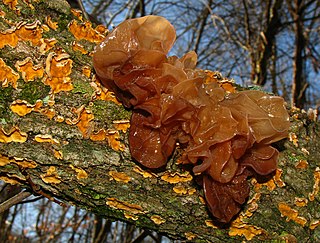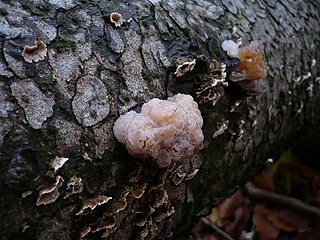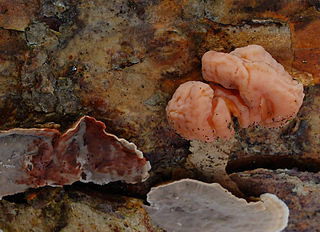Helicobasidium longisporum is a species of fungus in the subdivision Pucciniomycotina. Basidiocarps are corticioid (patch-forming) and are typically violet to purple. Microscopically they have auricularioid basidia. Helicobasidium longisporum is an opportunistic plant pathogen and is one of the causes of violet root rot of crops and other plants. DNA sequencing suggests that it is a complex of more than one species.

Ceratobasidium is a genus of fungi in the order Cantharellales. Basidiocarps are effused and the genus is sometimes grouped among the corticioid fungi, though species also retain features of the heterobasidiomycetes. Anamorphic forms were formerly referred to the genus Ceratorhiza, but this is now considered a synonym of Rhizoctonia. Ceratobasidium species, excluding the type, are also now considered synonymous with Rhizoctonia and some species have been transferred to the latter genus. Species are saprotrophic, but several are also facultative plant pathogens, causing a number of commercially important crop diseases. Some are also endomycorrhizal associates of orchids.

The Tulasnellaceae are a family of fungi in the order Cantharellales. The family comprises mainly effused (patch-forming) fungi formerly referred to the "jelly fungi" or heterobasidiomycetes. Species are wood- or litter-rotting saprotrophs, but many are also endomycorrhizal associates of orchids and some have also been thought to form ectomycorrhizal associations with trees and other plants.

Tulasnella is a genus of effused (patch-forming) fungi in the order Cantharellales. Basidiocarps, when visible, are typically smooth, ceraceous (waxy) to subgelatinous, frequently lilaceous to violet-grey, and formed on the underside of fallen branches and logs. They are microscopically distinct in having basidia with grossly swollen sterigmata on which basidiospores are formed. One atypical species, Tulasnella aurantiaca, produces orange to red, gelatinous, pustular anamorphs on wood. Some species form facultative mycorrhizas with orchids and liverworts. Around 80 species of Tulasnella are known worldwide.

Volvopluteus michiganensis is a species of mushroom in the family Pluteaceae. It was originally described under the name Pluteus michiganensis but molecular studies have placed it in the Volvopluteus, a genus described in 2011. The cap of this mushroom is about 7–9 cm (2.8–3.5 in) in diameter, gray, and has a cracked margin that is sticky when fresh. The gills start out as white but they soon turn pink. The stipe is white and has a volva at the base. Microscopical features and DNA sequence data are of great importance for separating this taxon from related species. V. michiganensis is a saprotrophic fungus that was originally described as growing on sawdust. It has only been reported from Michigan (US) and the Dominican Republic.

Phaeotremella is a genus of fungi in the family Phaeotremellaceae. All Phaeotremella species are parasites of other fungi and produce anamorphic yeast states. Basidiocarps, when produced, are gelatinous and are colloquially classed among the "jelly fungi". Fifteen or so species of Phaeotremella are currently recognized worldwide. Tremella sanguinea, shown to be a Phaeotremella species by DNA sequencing, is cultivated in China as an ingredient in traditional Chinese medicine.

Phaeotremella frondosa is a species of fungus in the family Phaeotremellaceae producing brownish, frondose, gelatinous basidiocarps. It is widespread in north temperate regions, and is parasitic on other species of fungi that grow on dead attached and recently fallen branches of broadleaf trees.

Naematelia is a genus of fungi in the family Naemateliaceae. All Naematelia species are parasites of other fungi and produce anamorphic yeast states. When produced, Basidiocarps ,, are gelatinous and are colloquially classed among the "jelly fungi."Four species of Naematelia are currently recognized worldwide. One species, Naematelia aurantialba, is commercially cultivated for food.

Naematelia aurantia is a species of fungus producing yellow, frondose, gelatinous basidiocarps. It is widespread in north temperate regions and is parasitic on another species of fungus that grows on dead attached and recently fallen branches of broadleaf trees. It is commonly called golden ear in North America.

Naematelia encephala is a species of fungus producing pink, brain-like, gelatinous basidiocarps. It is widespread in north temperate regions and is parasitic on another species of fungus that grows on dead attached and recently fallen branches of conifers. In the UK, its recommended English name is conifer brain.

Cystobasidium fimetarium is a species of fungus in the order Cystobasidiales. It is a fungal parasite forming small gelatinous basidiocarps on various ascomycetous fungi on dung. Microscopically, it has auricularioid basidia producing basidiospores that germinate by budding off yeast cells. The species is known from Europe and North America.

Sirobasidium is a genus of fungi in the order Tremellales. Basidiocarps are gelatinous and appear to be parasitic on ascomycetous fungi on wood. Microscopically they are distinguished by producing septate basidia in chains which give rise to deciduous sterigmata. Species are distributed worldwide.
Phaeotremella fimbriata is a species of fungus in the family Phaeotremellaceae. It produces blackish, frondose, gelatinous basidiocarps and is parasitic on the mycelium of Stereum rugosum, a fungus that grows on dead attached and recently fallen branches of broad-leaved trees. It is widespread in northern Europe. Prior to 2017, the species was generally considered a synonym of Tremella foliacea, but this latter species is restricted to conifers. Phaeotremella frondosa is a similar-looking but paler, brown species on broad-leaved trees and occurs in North America as well as Europe.
Phaeotremella roseotincta is a species of fungus in the family Phaeotremellaceae. It produces pinkish to pale pinkish brown, frondose, gelatinous basidiocarps and grows on dead attached and recently fallen branches of broad-leaved trees. It was originally described from Japan and has also been recorded from far eastern Russia.
Tremella brasiliensis is a species of fungus in the family Tremellaceae. It produces yellow, lobed to firmly foliaceous, gelatinous basidiocarps and is parasitic on other fungi on dead branches of broad-leaved trees. It was originally described from Brazil.
Tremella roseolutescens is a species of fungus in the family Tremellaceae. It produces rose-pink to salmon, pustular, gelatinous basidiocarps and is parasitic on other fungi on dead attached branches of broad-leaved trees. It was originally described from Costa Rica.
Tremella salmonea is a species of fungus in the family Tremellaceae. It produces pale orange to salmon, foliose, gelatinous basidiocarps and is parasitic on other fungi on wood of broad-leaved trees. It was originally described from China.
Tremella versicolor is a species of fungus in the family Tremellaceae. It produces small, pustular, gelatinous basidiocarps and is parasitic on the basidiocarps of Peniophora species, a genus of corticioid fungi, on dead attached or recently fallen branches. It was originally described from England.
Tremella mesenterella is a species of fungus in the family Tremellaceae. It produces yellowish to reddish brown, foliose, gelatinous basidiocarps and is parasitic on corticioid fungi on dead branches of broadleaf trees and shrubs. It was originally described from Canada.
Phaeotremella translucens is a species of fungus in the family Phaeotremellaceae. It produces small, pustular, gelatinous basidiocarps and is parasitic on ascocarps of Lophodermium species on decaying pine needles. It was originally described from Scotland.










